Low Iron Glass Vs Standard Clear Glass Vs Acrylic For Aquarium Windows [2025]

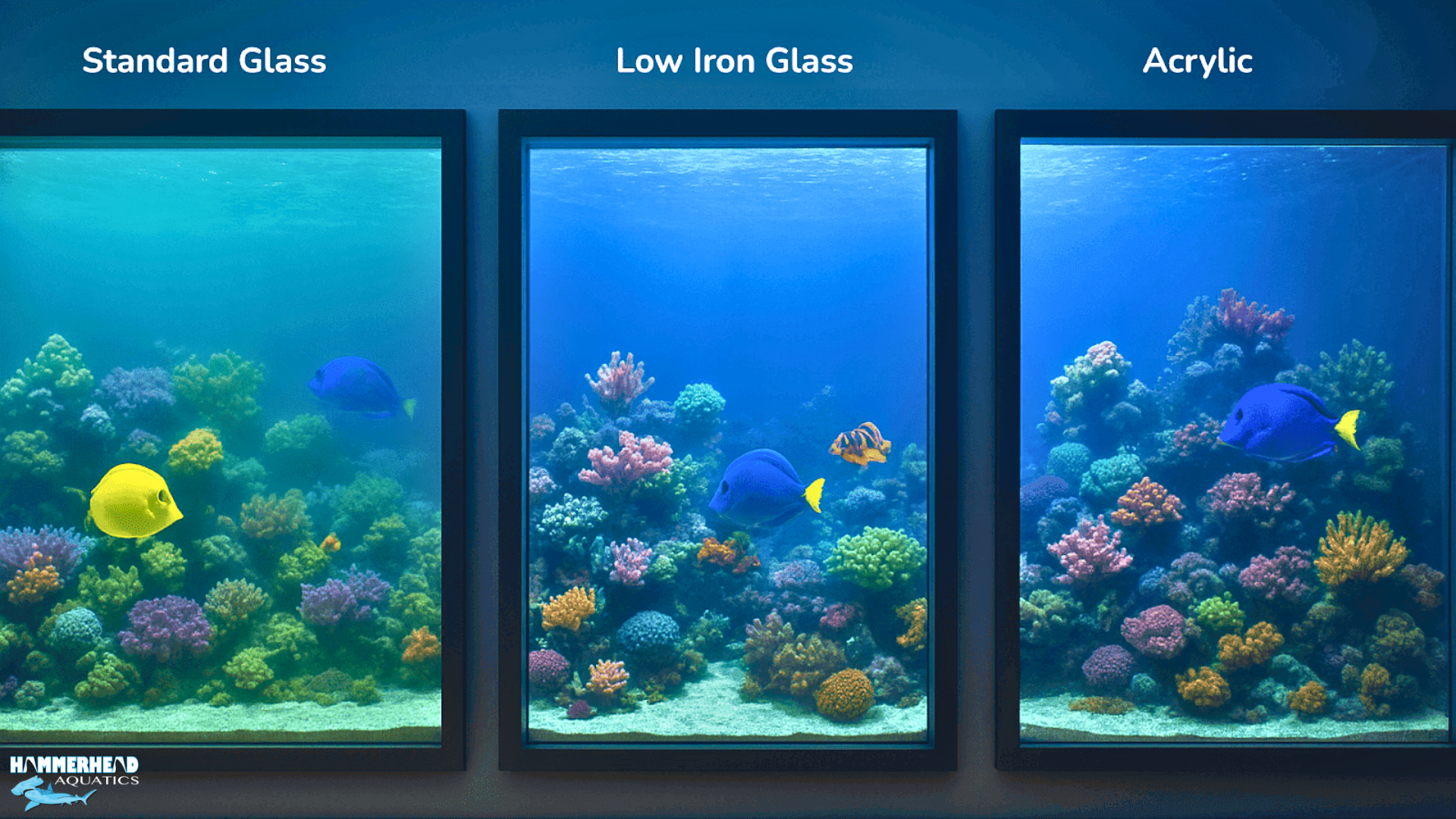
After installing aquarium windows for luxury villas in Dubai, shark tunnels in public zoos, and 2,000+ gallon reef tanks in private homes, I’ve had enough experience to understand what material is best for what type of aquariums.
Many often ask,
“Should I go with low iron glass, regular glass, or acrylic for my aquarium window?”
Most people assume the answer is simple. It isn’t.
I’ve seen hobbyists regret choosing acrylic after realizing how easily it scratches. I’ve replaced standard glass panels because the green tint muffled the colors of their fish. And I’ve had builders insist low iron glass was “overpriced hype”, until I installed it and they literally thought the tank had no front panel.
So in this guide, I won’t give you marketing fluff: I’ll teach you like I do when designing real installations, backed by hands-on experience, real price data, and application-based reasoning, so you can choose confidently.
Although, I always say, leave the choice to experts (provided that you contacted someone with a proven track record).
Now let’s begin.
TL;DR - Key Takeaways
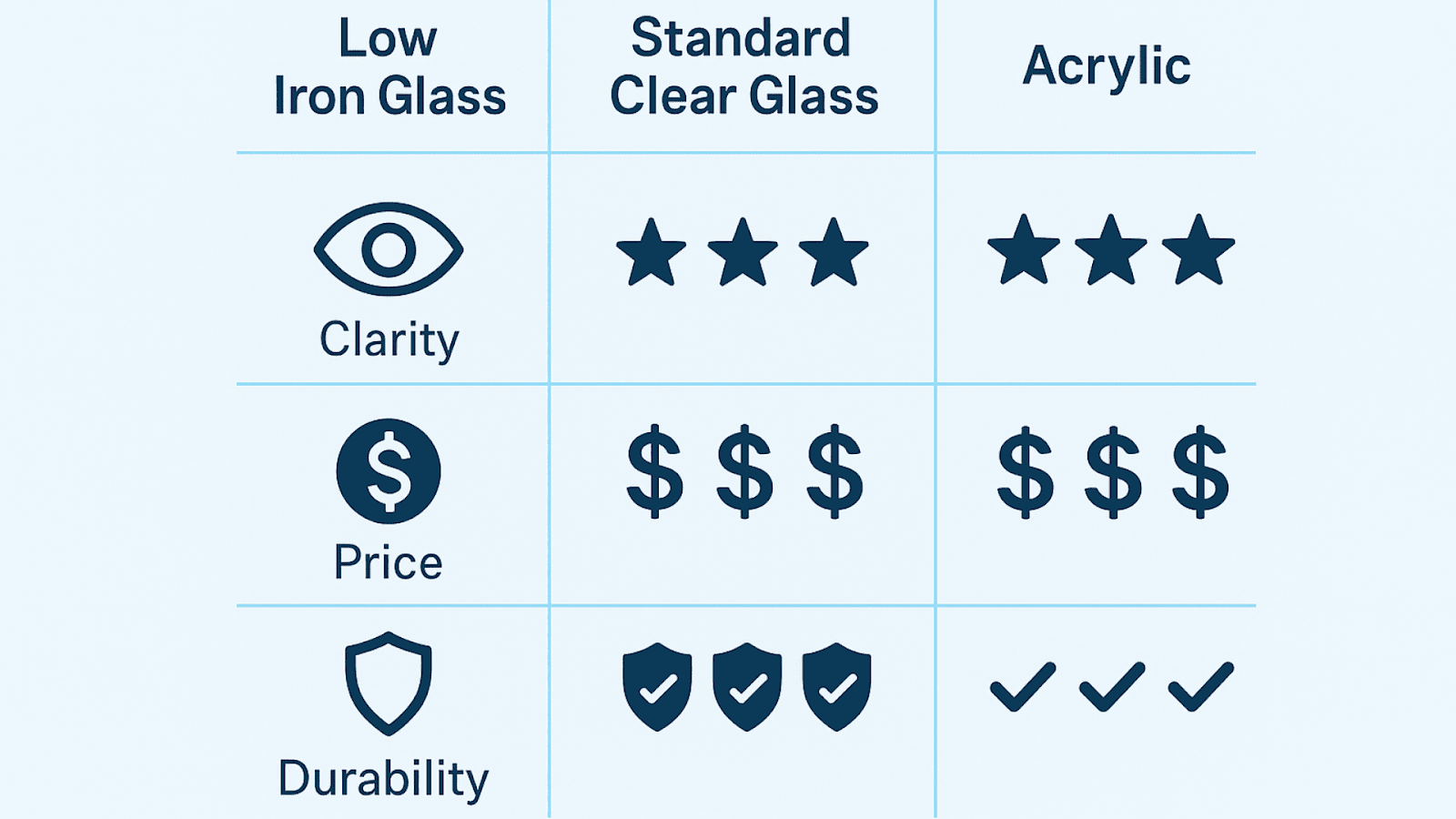
- Low iron glass gives the clearest, most color-accurate view.
- Prices of low iron glass have dropped enough in 2025. So it’s now accessible for serious hobbyists.
- Standard clear glass is still king for budget builds, but you’ll always notice that green tint once you’ve seen low iron.
- Acrylic wins in impact resistance and flexibility, which is why public aquariums love it.
- Acrylic scratches so easily that most home users eventually regret it and use some other material.
- Want a permanent, crystal-clear display with low maintenance? Choose low iron.
- Want the lowest cost? Standard glass.
- Need curved or massive panels? Acrylic.
- To understand which one suits your requirements based on size, location, and design, it’s best to consult with experts (such as Hammerhead Aquatics) to avoid long-term mishaps.
Now let’s get into the details.
What Is Low Iron Glass for Aquariums?

Low iron glass is essentially clear glass without the green tint. Normal glass contains iron oxide, which gives it that subtle emerald tone, especially visible on thick panes.
Manufacturers reduce that iron content to create what brands like Starphire, Optiwhite, or UltraClear sell as premium clarity glass.
In practice, what does that mean?
When you light up a reef tank through standard glass, bright yellow tangs look slightly greenish. Through low iron glass, they look like someone turned the saturation up, but naturally.
I once replaced a 19mm standard glass panel on a 400-gallon reef tank for a client in Singapore. His exact words after the swap:
“It looks like I upgraded my fish instead of the glass.”
What Is Standard Clear Glass For Aquariums?
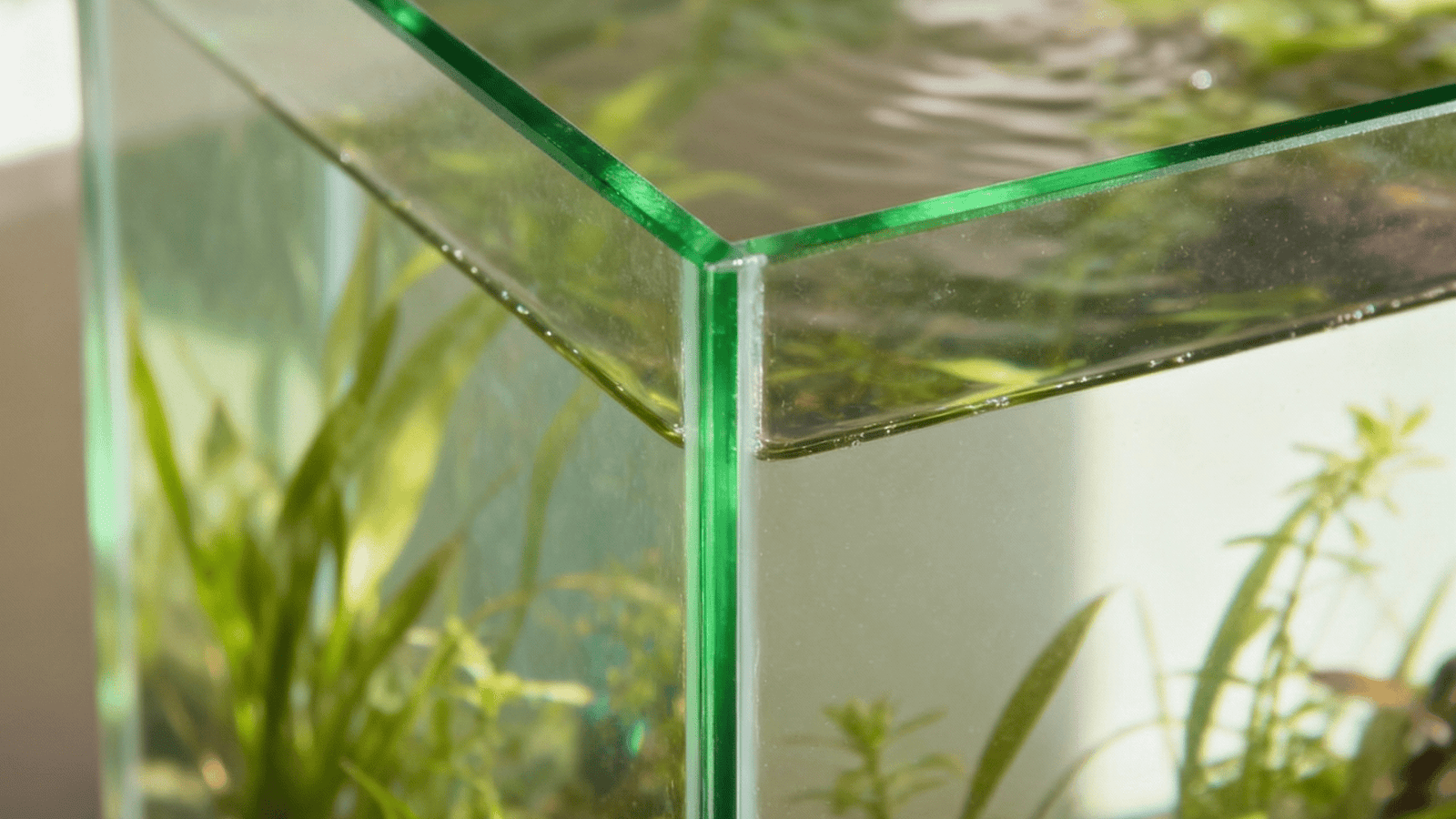
Standard clear glass, often called float glass, is the default choice for most aquariums. It’s strong, affordable, readily available anywhere, and resistant to scratches.
That’s why almost every budget commercial tank or freshwater setup uses it.
However, that green tint becomes more obvious as thickness increases.
For a 6mm standard glass tank? It’s hardly noticeable.
But for a 15mm or 19mm front panel? You’ll see a noticeable green border and muted color tones. In fish-only or planted tanks, this is tolerable. But if you’re a reef keeper or aquascaper chasing aesthetics, you’ll eventually crave more clarity.
Think of standard glass as the Toyota Corolla of aquarium materials; dependable, affordable, does the job. But it’s not a Ferrari. 😅
What Is Acrylic for Aquariums?
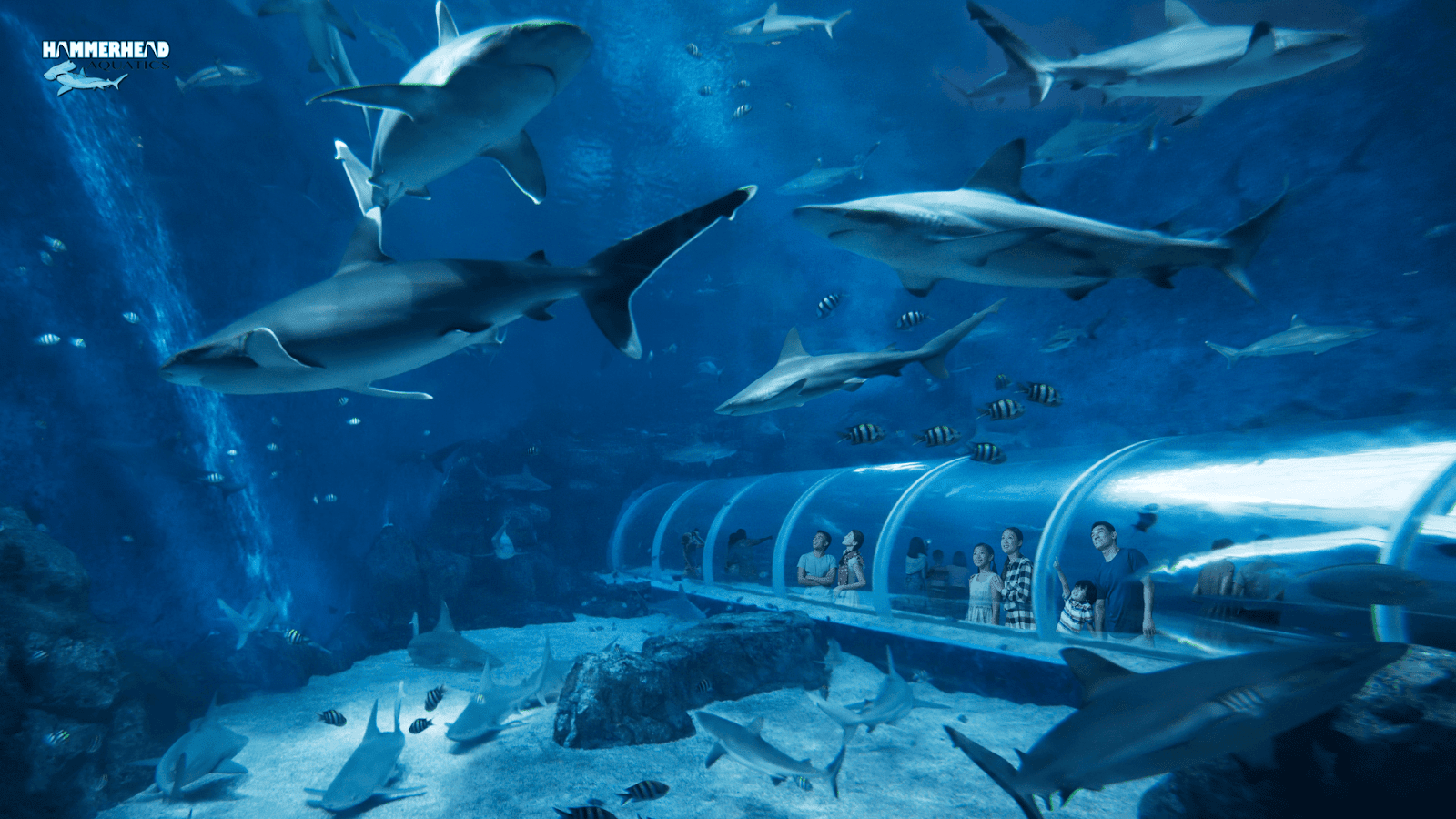
Acrylic (PMMA) is a lightweight, impact-resistant plastic often used in public aquariums and curved displays. It’s clearer than standard glass when new and can be molded into tunnels, cylinders, or bow fronts… things you simply can’t do with glass.
But here’s the catch: acrylic scratches if you so much as look at it the wrong way.
I’ve seen homeowners ruin a $5,000 acrylic front panel in three months by using the wrong algae scraper. Kids touching it with rings? Instant swirl marks. And while polishing can restore clarity, it’s an ongoing chore.
So acrylic is amazing when impact resistance or shape flexibility matters. But if you want set-it-and-forget-it clarity, it requires discipline most people don’t have.
Direct Comparison: Low Iron Glass vs Standard Glass vs Acrylic

Let’s compare them across real-world factors that matter when you live with one of these materials, not just look at spec sheets.
1. Clarity & Color Accuracy
Low iron glass is where your fish finally look like they do on YouTube. The transparency is so clean that many first-time viewers assume there’s no front panel at all. I once installed a 2.5-meter low iron panel for a hotel lobby, and guests kept trying to touch the water.
Standard glass, on the other hand, isn’t actually “clear”. It’s green-filtered. It’s like wearing green-tinted sunglasses without realizing it. You won’t notice this on thin tanks, but once you cross 12mm thickness, it starts to dull reds and yellows noticeably.
Acrylic starts out just as clear as low iron glass, sometimes even slightly clearer. But here’s the problem… that clarity doesn’t age gracefully. UV exposure and cleaning micro-scratches eventually give it a permanent haze unless maintained religiously.
2. Scratch Resistance
Glass — both low iron and standard — is remarkably scratch-resistant. You could scrub it with a metal algae blade, clean it with sand caught in the sponge, or even accidentally hit it with a rock, and it would likely stay intact. That’s why I love glass for homes with kids, pets, or rough maintenance habits. (Ironic when you think of glass as an item that shatters when broken. But trust me, the glass used for aquariums is not so easy to shatter.)
Acrylic, unfortunately, is like owning a black grand piano: stunning until someone runs a fingernail across it. Even the soft side of a magnet cleaner can leave marks if a grain of sand gets caught. You can buff out scratches with polishing compounds, but it’s like owning a sports car that needs waxing every weekend.
3. Strength and Durability Under Pressure
Acrylic wins in impact strength hands down. If you take a hammer to a glass panel, it will shatter (especially if it’s not laminated or tempered correctly). Acrylic will flex and absorb the shock like a trampoline.
But here’s what most people don’t understand: flexing isn’t always a good thing.
In a 2-meter-wide aquarium, a glass panel stays rigid. On acrylic, you’ll notice a slight outward bow over time, even if it’s thick. Some people don’t mind this. Others find it psychologically unsettling, as if the tank is “about to pop.” 🧐
4. Weight & Installation Handling
If you’ve ever tried to lift a 19mm glass panel, you’ll know pain. Glass is heavy, and a large low iron front panel may require four to six men to position safely.
Acrylic is roughly 50% lighter, which makes it a blessing during installation. I’ve built entire feature walls with single-piece acrylic panels that would have been physically impossible with glass.
If you’re mounting a tank at height or building on weaker structures, acrylic is often the safer option simply by weight.
5. Longevity Over the Years
If you want a material that looks the same in year 20 as it did on day one, low iron glass is king. It does not yellow, does not haze, does not warp. Standard glass lasts nearly as long but always carries that green tint that limits visual quality.
Acrylic, meanwhile, ages like a sports car: beautifully if pampered, horribly if neglected. I’ve seen 8-year-old acrylic windows that look like someone smeared Vaseline across them permanently because nobody used the right cleaning pads.
6. Maintenance & Cleaning Practicality
Glass loves abuse. You can use razor scrapers, hard-bristle pads, or algae magnets without fear. You can accidentally get sand between a scrubber and the pane and still walk away scratch-free.
With acrylic, you’re always cleaning with fear.
- Everything must be microfiber.
- Everything must be soft.
- You must use acrylic-safe pads only, or else you’ll build a spiderweb of micro-scratches that become visible the moment light hits from an angle.
If you’re the type who wants to wipe and move on, pick glass.
7. Price & Cost-to-Benefit Ratio (2025 Data)
Standard glass is still the cheapest option, making it ideal for large tanks on a budget. Low iron glass used to be nearly 2x more expensive, but thanks to increased production and competition, prices have dropped by 15–20% since 2020.
For perspective:
- 10mm Thickness (per square meter):
- Standard Glass: $80–$110
- Low Iron Glass: $130–$160
- Acrylic: $180–$220
- 19mm Thickness (per square meter):
- Standard Glass: $180–$220
- Low Iron Glass: $260–$310
- Acrylic: $340–$400
- 30mm Thickness (per square meter):
- Standard Glass: $350–$450
- Low Iron Glass: $480–$550
- Acrylic: $600–$750
If you're building a single viewing panel, low iron is usually worth the upgrade. If you're doing entire walls or tunnels, acrylic becomes more cost-effective due to fabrication efficiency.
Summary - Low Iron Glass vs Standard Glass vs Acrylic for Aquariums
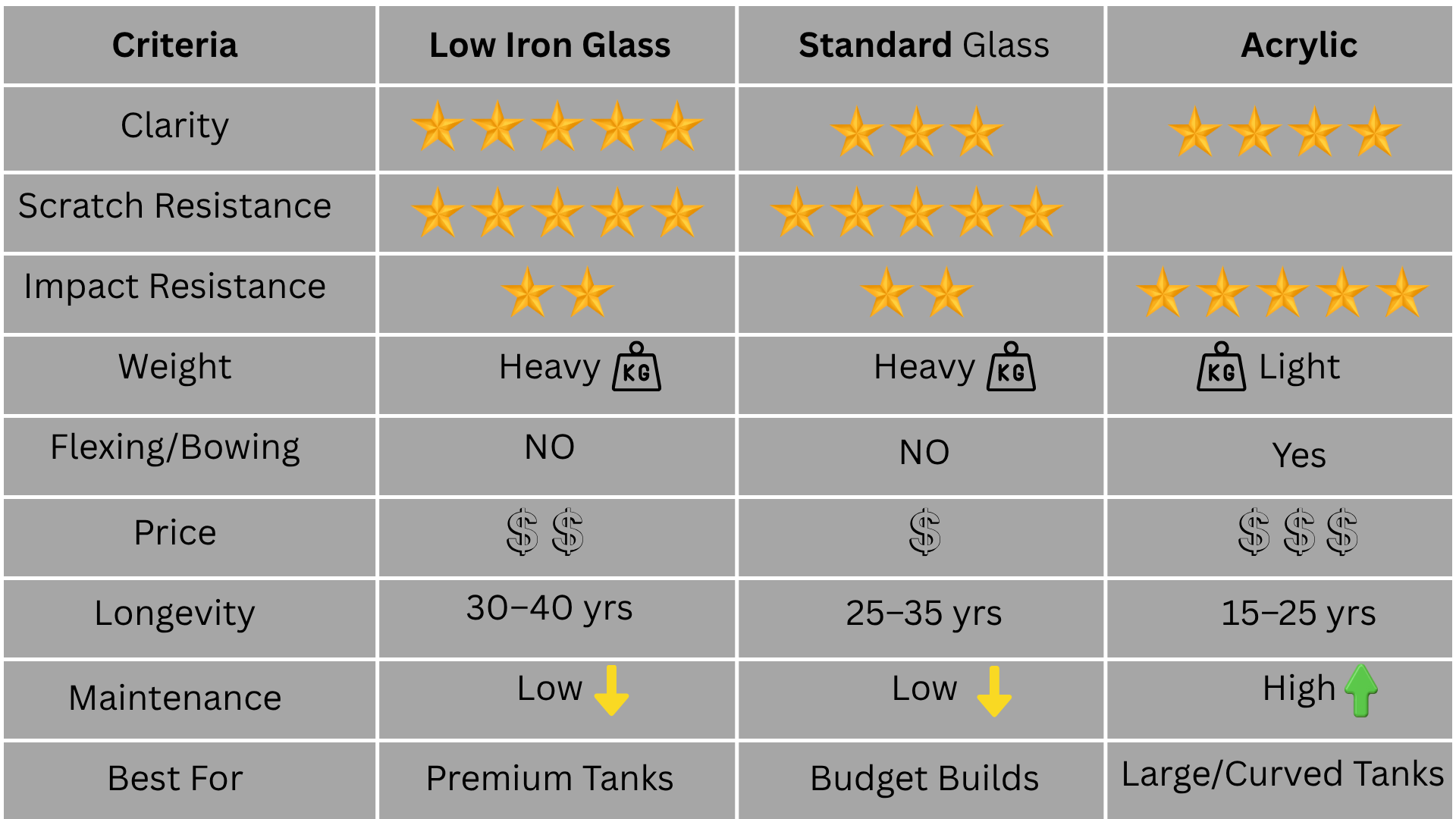
- Low Iron Glass
- Near-perfect clarity, no green tint
- Most expensive option
- Heavy, brittle, hard to repair if cracked
- Excellent scratch resistance
- Best for showcase, luxury, or premium display tanks
- Standard Clear Glass
- Noticeable green tint, less clarity
- Cheapest and most widely available
- Heavy, brittle, shatters with impact
- Best scratch resistance
- Good for budget tanks or where color fidelity isn’t critical
- Acrylic
- Very clear, light blue tint when thick
- Mid-range cost, price rises quickly with thickness
- Lightweight, very strong, flexes under load
- Scratches easily but can be repaired or polished
- Best for custom shapes, curves, deep tanks, and safety
Final Thoughts

Choosing your aquarium window material is more just about strength. It depends more on how you want to see your fish for years to come.
If you value clarity, color accuracy, and low maintenance, low iron glass is the ultimate modern choice in 2025.
If you’re building on a budget and don’t mind a little green tint, standard glass still delivers rugged performance.
If you need curved shapes, tunnels, or kid-proof impact strength, acrylic is unmatched, as long as you're willing to maintain it properly.
Expert Aquarium Window Design & Installation

If you're planning a build, whether it’s a home reef display or a commercial feature wall. You may consider reaching out to my team at Hammerhead Aquatics. We have decades of experience on this and can ensure accuracy in calculating glass thickness, panel reinforcement method, sealant type, and load tolerance based on real engineering practices. You may reach us for a free quote.
In case you have questions or opinions about this guide, feel free to leave a comment. I will be happy to reply.
Cheers!
FAQs
1. Is low iron glass worth the extra cost?
Absolutely. If your tank is over 200 liters and contains colorful livestock. On smaller tanks, the difference is subtle. On large panels, the clarity jump is dramatic.
2. Can you mix low iron glass and standard glass in one tank?
Yes. Many builders use low iron only on the viewing panel and standard glass elsewhere to save cost without sacrificing appearance.
3. Does acrylic really scratch that easily?
Yes. Even wiping it with a rough cloth can leave haze. It’s beautiful when new but requires discipline to keep clean.
4. Which is better for saltwater aquariums?
Low iron glass. Acrylic scratches fast during coral growth cleanup. Saltwater systems demand frequent scraping; glass handles it effortlessly.
5. Can acrylic bow over time?
Yes, especially if the builder used minimal thickness. Always oversize acrylic panels by 30–40% above calculated thickness to reduce bowing.
Paragraph For choosing aquarium windows, start by considering your visibility needs, tank size, budget, and desired effect. Low iron glass is the best option for perfect color fidelity and clear visuals; use it for luxury tanks and where presentation is paramount. Acrylic is unmatched for safety, size, custom shapes, and deep tanks, but be mindful of maintenance. Standard clear glass remains the economic choice for basic aquariums. Consult professionals like Hammerhead Aquatics before ordering, as installation complexity and glass thickness play a major role in overall performance and longevity. Invest wisely in the right material to enjoy a stunning, safe, and durable aquarium for years to come.











